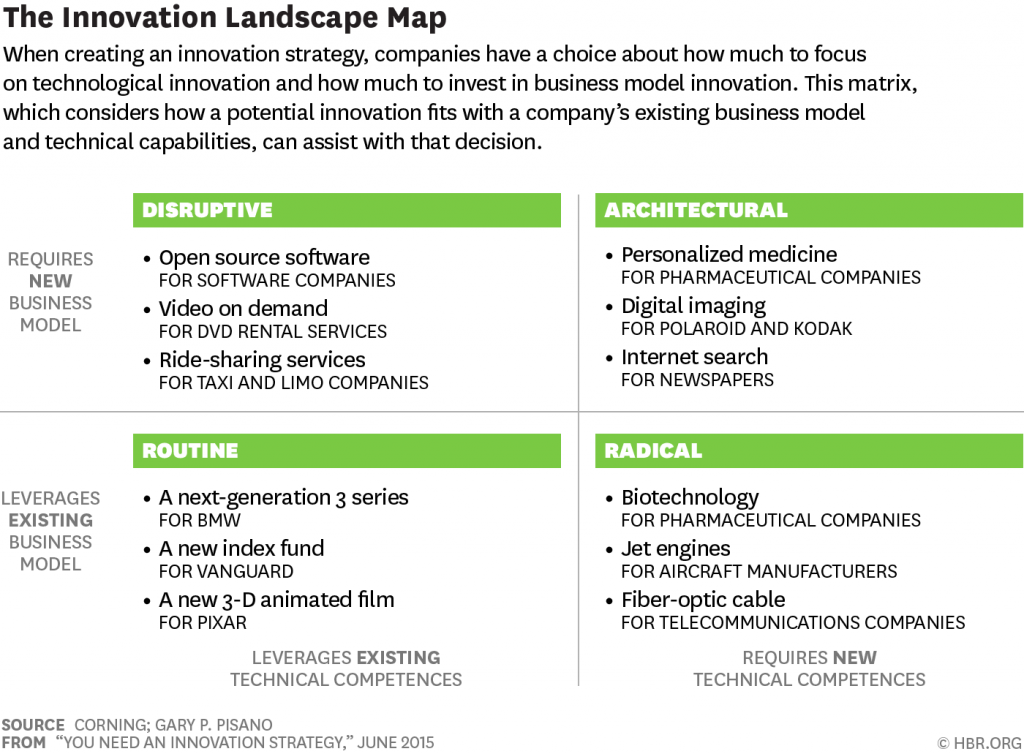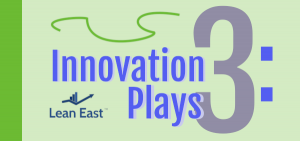Our two previous posts introduced the Need for Lean Innovation and Lean Startup Thinking. In our conversations about Startup Thinking and Innovation, we want to clearly encourage that these innovative tools and strategies work for established companies equally as well as they do for start-ups. In fact, most of the companies Lean East supports are mature companies, not early-stage companies with a nascent product idea to test.
Throughout this post, we show that there are four primary types of innovation for existing companies, as presented in the Harvard Business Review article “You need an Innovation Strategy,” by Gary P. Pisano in 2015. The four types are described by whether they feature a business model innovation or technical competency innovation. Then we share three suggestions for existing companies who want to innovate.
The Innovation Landscape
Routine or incremental innovation leverages existing technical competencies and business model structures with product enhancements. Many large, successful companies attempt to benefit from incremental innovation forever. This often works, until one day a competitor uses one of the other three innovation types.
Radical innovation comes from investment in technology and R&D. For example, a new drug that has far superior benefits to what is currently on the market. Some new products outperform the current products so much that they take over the market. Think of what CDs and DVDs did to the cassette tape market and what digital media did to physical media of any kind. . .
Disruptive innovation leverages a new business model, or way of generating revenue from customers, for the company to earn market share. This new business model often challenges or disrupts the business model used by the current market leaders in the space.
Architectural innovation uses new technology in a new type of business model for the market. This is the most complex innovation but provides for a significant competitive advantage when successful.

Mature Organization Challenges
We have seen many businesses that innovate successfully in the incremental and radical dimensions. Disruptive and architectural innovation is typically more challenging in established companies for several reasons.
First, the established company is often reluctant to challenge its existing market position with a different business model. Netflix is one of the few examples we can think of that obsoleted its own successful business model while it was a market leader. Their leadership rightly realized that online streaming services were more efficient than mailing discs, and they created a business model that worked.
In addition, another reason existing companies struggle is their current organizational structure may not be a fit for the innovative idea to be able to take it to scale. In their ‘Architectural Innovation’ work, Harvard professors, Rebecca Henderson and Kim B. Clark highlighted the fact that what matters is not whether an innovation is breakthrough or incremental. In fact, what matters is whether the company’s current structures can absorb the innovation and take it to scale.
Three Innovation Suggestions
Lean East has three suggestions for existing companies who want to innovate:

- Create an “Innovation Strategy”
The first step is to make innovation a priority part of your strategic vision. We believe “experimentation to learn what customers value” must be your primary goal. A strategic plan for innovation should be created by upper management working with all levels of the organization.
- Strategically consider Innovation in all three areas: Incremental Improvements, Technical competencies, and New Business Models.
Lean East specializes in continuous improvement methods that support incremental enhancements. Our team and partners also lead clients through exercises that assess and review technical competencies and business models. We have facilitated numerous SWOT analysis workshops to help begin a conversation with business leaders looking to position themselves for successful growth. Ask us to put your new idea through our Lean canvas model to see if it is worth pursuing.
We help clients broaden their market definition and reimagine their business. Where do your strengths and market opportunities align? Can you, your employees, or your customers, identify potential “blue ocean” markets?
- Establish an Innovation Process
It is critical to establish practices at your organization that enables innovation for each member of your team. You must continually study and learn what customers value. Employees must be allowed the time (and trust) to test out new ideas.
The results of experiments must be shared and used for learning. We believe large companies must “fire bullets, then cannonballs.” The bullets represent simple, inexpensive innovations. When a test bullet hits the target and customers love it, you must next focus concentrated efforts on this path (fire the cannonball).
Share Your Feedback
We would love to hear your comments, either by leaving a note below or sending an email. Lean East has supported innovations and innovators for years and sees many innovation opportunities in the services-based business sectors we often work in. Please contact Lean East President Steve Musica if you want support with innovation at your organization.


Related Posts
The God Complex: Why We’re All Making This One Mistake
How I am Changing the Career Advice I Give My Kids
This is Never Going to Work: Getting Lean Projects Unstuck